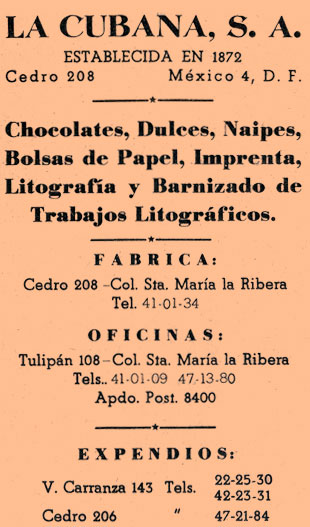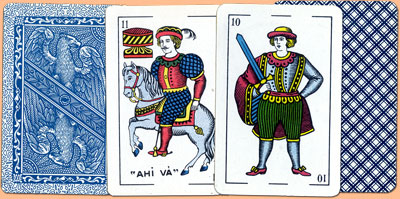La Cubana, S.A.
La Cubana were successors to P. Munguia, who were founded in 1872. The company closed n 1995 bringing to a close Mexico's longest standing playing-card factory.
LA CUBANA were successors to P. Munguia, who were founded in 1872. This information is usually stated on the four of coins or cups. The date of transfer of the name is believed to be around 1940. Also, the trade mark "El Aguila" often appears on the ace of coins. The price list inside their 1962 catalogue gives all the various types of playing cards produced at that time, as shown in the list of links above, as well as other speciality items such as chocolates, paper bags and lithographic printing services. It can be seen that La Cubana produced several versions of the Spanish Cadiz style amongst their range. Other brands not included in this catalogue are: “El Águila Nueva” (new design), “El Turco”, Naipes “Mignon” (earlier versions), the later standard English packs and several Jumbo Index editions (“Numerus Magnus”). Packs of seconds (slightly damaged cards) were also sold, called “Tripulo”.
Various addresses are given for the factory, the administration offices and other sales outlets (above left) which over the years also appeared on the cards and wrappers giving the impression that the business kept changing address. At some more recent date the company name changed to “La Cubana, S. A. de C.V.” and the factory address changed to: Nogal No.187, along with new fax numbers. The company finally closed down in 1995 thus bringing to a close Mexico's longest standing playing-card factory.

By Simon Wintle
Member since February 01, 1996
I am the founder of The World of Playing Cards (est. 1996), a website dedicated to the history, artistry and cultural significance of playing cards and tarot. Over the years I have researched various areas of the subject, acquired and traded collections and contributed as a committee member of the IPCS and graphics editor of The Playing-Card journal. Having lived in Chile, England, Wales, and now Spain, these experiences have shaped my work and passion for playing cards. Amongst my achievements is producing a limited-edition replica of a 17th-century English pack using woodblocks and stencils—a labour of love. Today, the World of Playing Cards is a global collaborative project, with my son Adam serving as the technical driving force behind its development. His innovative efforts have helped shape the site into the thriving hub it is today. You are warmly invited to become a contributor and share your enthusiasm.
Related Articles

Tarot de Valverde de la Vera
A series of 24 surrealist engravings by Mexican artist Claudio Favier in which archetypal Tarot alle...

Visite Mexico
Promoting Mexican tourism with 54 different photographs in full colour.

Tarot Baraja Egipcia
Curious Tarot with Egyptian-style trumps issued by Franco Mora Ruiz from Mexico.

Mexican ethnic playing cards
Mexican ethnic groups depicted on playing cards by Fábrica de Naipes Cuauhtemoc.

Santo Mexico playing cards
Santo Mexico playing cards designed by Cédric Volon with Mexico-associated symbols.

Battles in Mexico, 1847
Uncut proof sheet with Mexican Battle scenes on the aces and portraits of American generals on the c...

Asha Industries’ Castilian pattern
Colourful Spanish (Castilian) pattern cards made by Asha Industries in India for Mexico.

Calaveras De Azúcar
Calaveras De Azúcar playing cards produced by Natalia Silva, USA, 2017.

Baraja Nefertiti
Mexican fortune-telling pack with black and white designs by Thania Nicolopulus.

Mexican Artdeck
Works by 14 different 20th century Mexican artists.

Baraja Maya
Original designs inspired by Mayan art and culture published by Fernando Güemes, Mexico.

Naipe Centenario
Latin American designs by Productora de Naipes y Confetti (Pronaco), S.A., Mexico, c1980.

Spanish pattern by Productos Leo, S.A.
Colourful Mexican version of standard Spanish designs, by Productos Leo, S.A., c.1980s.

Tonalamatl
Baraja Tonalamatl Mexican Aztec playing cards based on the prehispanic Codex Borgia manuscript.

Baraja Taurina Toranzo
Baraja Taurina Mexicana Toranzo with paintings by Antonio Navarrete, 2003

Gallo Intransparente
Gallo Extra Intransparente by Clemente Jacques y Cia S.A., Mexico.
Most Popular
Our top articles from the past 28 days






